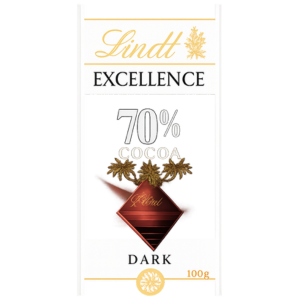
Lindt Dark Chocolate
Caffeine
20–35 mg
Note: Caffeine amounts are based on typical Lindt Excellence dark chocolate formulations and vary by cocoa percentage and serving size. Higher cocoa content (90%–99%) contains more caffeine per gram.
| Attribute | Value |
|---|---|
| Caffeine Level | Moderate |
| Serving Size | 1 oz (28 g) |
| Caffeine | 20–35 mg |
| Calories | 170 kcal |
| Sugar | 5 g (85% cocoa) |
Lindt dark chocolate is known for its smooth texture, rich cocoa flavor, and premium quality. Alongside its indulgent taste, it naturally contains caffeine from cocoa solids.
What is Lindt Dark Chocolate?
Known for its Excellence range, Lindt offers bars with cocoa content from 50% to 99%, each delivering a different balance of bitterness, sweetness, and caffeine.
The company’s headquarters and main factory are located in Kilchberg, Switzerland, home to the Lindt Home of Chocolate museum 1. However, Lindt also operates production facilities in Germany, Italy, France, Austria, and the United States (Stratham, New Hampshire) to serve global markets.
- Premium Cocoa Beans – Sourced from select regions for consistent flavor.
- Wide Cocoa Range – From milder 50% to intense 99% cocoa solids.
- Smooth Texture – Achieved through Lindt’s signature conching process.
- Variety of Formats – Bars, truffles, and seasonal specialties.
- Swiss Heritage, Global Reach – Produced in multiple countries to meet worldwide demand.
This blend of craftsmanship, heritage, and global production makes Lindt dark chocolate a favorite for both casual chocolate lovers and connoisseurs.
How Much Caffeine is in Lindt Dark Chocolate?
Caffeine in Lindt dark chocolate comes directly from cocoa solids — the higher the cocoa percentage, the more caffeine per gram. Serving size also plays a big role in total intake.
- Excellence 70% Cocoa – 20 mg caffeine per 1 oz (28 g); 70 mg per 3.5 oz (100 g) bar.
- Excellence 85% Cocoa – 23 mg per 1 oz; 80 mg per 100 g bar.
- Excellence 90% Cocoa – 27 mg per 1 oz; 95 mg per 100 g bar.
- Excellence 95% Cocoa – 30 mg per 1 oz; 105 mg per 100 g bar.
- Excellence 99% Cocoa – 35 mg per 1 oz; 120 mg per 100 g bar.
While these amounts are modest compared to coffee, a large portion of high‑cocoa chocolate can still provide a noticeable caffeine lift.
Calories And Sugar
Lindt dark chocolate is calorie‑dense and nutrient‑rich, offering antioxidants alongside caffeine. Chocolate itself is naturally gluten‑free, but gluten can be introduced through added ingredients or cross‑contamination during production. Lindt does not certify its products as gluten‑free.
- Calories – 240 kcal per 40 g serving (85% cocoa).
- Sugar – 5 g in high‑cocoa bars; more in lower‑percentage varieties.
- Protein – 5 g per 40 g serving.
- Fat – 22 g, mostly from cocoa butter.
- Carbohydrates – 9 g in high‑cocoa bars.
- Gluten Risk – Some products may contain barley malt extract or be processed on shared equipment.
- Label Check – Always review ingredient lists and allergen statements.
For those with gluten sensitivity, plain high‑cocoa Lindt bars may be suitable, but anyone with celiac disease should proceed with caution due to cross‑contamination risk.
Ingredients Overview
Lindt dark chocolate’s ingredient list is short and focused on quality, especially in high‑cocoa varieties.
- Cocoa Mass – Primary source of flavor and caffeine.
- Cocoa Butter – Adds smoothness and melt‑in‑the‑mouth texture.
- Sugar – Balances bitterness; amount decreases as cocoa percentage rises.
- Vanilla or Natural Flavoring – Enhances aroma.
- Emulsifier (Soy Lecithin) – Improves texture and consistency.
This minimalist approach allows the cocoa’s natural complexity to shine.
Nutritional Facts at a Glance (Lindt Excellence 85% Cocoa, 40 g Serving)
A 40 g serving of Lindt Excellence 85% Cocoa offers a balance of indulgence and nutrition.
- Calories – 240 kcal
- Total Fat – 22 g
- Sodium – 5 mg
- Total Carbohydrates – 9 g
- Sugars – 5 g
- Protein – 5 g
- Caffeine – 32 mg
- Caffeine per 1 oz – 23 mg
Its caffeine level is moderate, making it a treat that can be enjoyed without the intensity of coffee — though portion control is key for both calorie and caffeine management.
